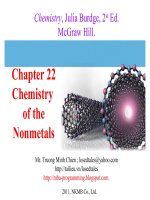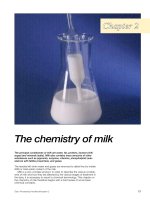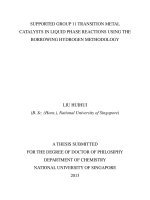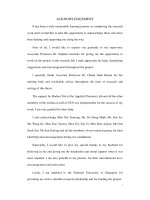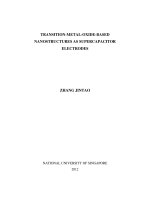Group 10 transition metal chemistry of benzannulated remote n heterocyclic carbene ligands
Bạn đang xem bản rút gọn của tài liệu. Xem và tải ngay bản đầy đủ của tài liệu tại đây (3 MB, 220 trang )
GROUP 10 TRANSITION METAL CHEMISTRY OF
BENZANNULATED/REMOTE N-HETEROCYCLIC
CARBENE LIGANDS
HAN YUAN
(B.Sc., SHANDONG UNIVERSITY)
A THESIS SUBMITTED FOR THE DEGREE OF
DOCTOR OF PHILOSOPHY
DEPARTMENT OF CHEMISTRY
NATIONAL UNIVERSITY OF SINGAPORE
2008
Acknowledgement
I
Acknowledgements
I would like to thank:
My supervisor Dr. Huynh Han Vinh for his invaluable guidance, inspiration and
patience over the whole course of my Ph.D. candidature. It is my good fortune to have
worked under him. All that he taught me in the past four years would be of great benefit
to my entire life.
The technical staff at Nuclear Magnetic Resonance, Mass Spectrometry, X-ray
diffraction and Elemental Analysis laboratories in our department for their technical
support. Special thanks to Ms Tan and Professor Koh Lip Lin for their great help in
measuring crystals as well as solving the structures and Mdm. Han for her kind help in
interpreting 2D NMR spectra.
Seah Lin, Sin Yee and Wei Lee for their really helpful discussions and friendship.
My past and present group members for their kind help and discussions. Special thanks
to Chun Hui, Hui Xian and Xiao Tien who became my good friends and made my life in
Singapore more enjoyable.
My parents for their unconditional love and support, without which I would not have
succeeded in doing a Ph.D. study overseas.
Other friends in Singapore or China, Xiaofeng, Ming Xing, Kien Voon, Jing Qiu,
Sheau Wei, Li Min, and Qin Ran for their constant support and encouragement.
NUS for my research scholarship.
Table of contents
II
Table of contents
Summary V
Chart 1. Compounds synthesized in this work VII
List of tables X
List of figures XI
List of schemes XIV
List of abbreviations XVI
1. Introduction 1
1.1. Definition of carbenes 1
1.2. Electronic structure, preparation and application of N-heterocyclic carbenes 3
1.3. Preparation and application of NHC complexes 8
1.4. Remote N-heterocyclic carbenes and their complexes 13
2. Palladium(II) and platinum(II) complexes with the 1,3-diisopropylbenzimi- 15
dazolin-2-ylidene ligand
2.1. Synthesis, reactivity and catalytic studies of the dimeric Pd(II) complex 15
[PdBr
2
(
i
Pr
2
-bimy)]
2
2.1.1. Synthesis 15
2.1.2. Reactivity studies 20
2.1.3. Catalytic studies in Suzuki-Miyaura coupling 52
2.2. Synthesis and catalytic studies of mononuclear bis(carbene) Pd(II) complexes 55
2.2.1. Synthesis 55
2.2.2. Catalytic studies in Mizoroki-Heck coupling 59
2.3. Synthesis and reactivity studies of Pt(II) complexes 62
Table of contents
III
2.3.1. Synthesis of the monocarbene complex [PtBr
2
(
i
Pr
2
-bimy)(DMSO)] 62
and the bis(carbene) complex [PtBr
2
(
i
Pr
2
-bimy)
2
]
2.3.2. Reactivity studies of [PtBr
2
(
i
Pr
2
-bimy)(DMSO)] 68
3. Palladium(II) complexes with the 1,3-dibenzhydrylbenzimidazolin-2- 73
ylidene ligand
3.1. Synthesis 73
3.2. Catalytic studies in Suzuki-Miyaura coupling 83
4. Palladium(II) complexes with pyrazole-based remote N-heterocyclic 87
carbene ligands
4.1. Synthesis and catalytic studies of mononuclear Pd(II) complexes with 87
pyrazolin-4-ylidene ligands
4.1.1. Synthesis 87
4.1.2. Catalytic studies in Suzuki-Miyaura coupling 96
4.2. Studies on the influence of 3,5-substituents in pyrazolin-4-ylidenes on 97
complexation
4.2.1. Synthesis of Pd(II) phosphine complexes with different pyrazolin- 98
4-ylidenes
4.2.2. Synthesis of Pd(II) pyridine complexes with different pyrazolin-4- 108
ylidenes
4.3. Synthesis of dinuclear or multinuclear Pd(II) complexes with pyrazolin-4 111
-ylidenes
4.3.1. Synthesis of iodo-bridged dinuclear Pd(II) complexes 111
4.3.2. Synthesis of di(pyrazolin-4-ylidene)-bridged dinuclear or 113
Table of contents
IV
multinuclear Pd(II) complexes
5. Conclusion 123
6. Experimental section 128
Appendix 178
References 193
Summary
V
Summary
This thesis deals with synthesis, reactivity and catalytic studies of group 10 (mainly
palladium) organometallic compounds bearing benzannulated or remote N-heterocyclic
carbene ligands. The findings of the research are presented in three chapters.
Chapter 2 describes the synthesis and properties of complexes with the
1,3-diisopropylbenzimidazolin-2-ylidene ligand (
i
Pr
2
-bimy). Reaction of the sterically
bulky 1,3-diisopropylbenzimidazolium bromide (A) with Pd(OAc)
2
in the presence of
NaBr yielded the monocarbene dimeric complex [PdBr
2
(
i
Pr
2
-bimy)]
2
(1) in high yield.
Complex 1 can be readily cleaved by CH
3
CN, salt A, PPh
3
, pyridyl or bipyridyl ligands,
isocyanides and different NHCs to afford monocarbene complexes with the respective
co-ligands. A preliminary catalytic study showed that complex 1 is a highly active
precatalyst in aqueous Suzuki-Miyaura coupling reactions. Three Pd(II) bis(carbene)
complexes (12-14) with the
i
Pr
2
-bimy ligand bearing different anionic co-ligands have
also been synthesized, and their catalytic activities studied in the Mizoroki-Heck coupling
reactions. In addition, the two Pt(II) complexes [PtBr
2
(
i
Pr
2
-bimy)(DMSO)] (15) and
[PtBr
2
(
i
Pr
2
-bimy)
2
] (16) were obtained when salt A was reacted with PtBr
2
in the
presence of NaOAc in DMSO. The reactivity of complex 15 with PPh
3
and pyridine was
studied.
1
H NMR and X-ray diffraction analyses revealed interesting intramolecular
C-HM anagostic interactions in all complexes with the
i
Pr
2
-bimy ligand synthesized in
this work.
Chapter 3 deals with a series of Pd(II) complexes with the
1,3-dibenzhydrylbenzimidazolin-2-ylidene ligand (Bh
2
-bimy). Reaction of sterically even
more demanding 1,3-dibenzhydrylbenzimidazolium bromide (C) with Pd(OAc)
2
in
Summary
VI
DMSO yielded a monocarbene Pd(II) complex (19) with a N-bound benzimidazole
derivative, which resulted from an unusual NHC rearrangement reaction. Reaction of C
with Ag
2
O, on the other hand, cleanly gave the Ag(I) carbene complex [AgBr(Bh
2
-bimy)]
(20), which was used as a carbene-transfer agent to prepare the acetonitrile complex
trans-[PdBr
2
(CH
3
CN)(Bh
2
-bimy)] (21). Dissociation of acetonitrile from complex 21 and
subsequent dimerization afforded the dinuclear Pd(II) complex [PdBr
2
(Bh
2
-bimy)]
2
(22)
in quantitative yield. Furthermore, the catalytic activity of complex 22 in aqueous
Suzuki-Miyaura cross-coupling reactions was studied and compared with that of its less
bulky analogue [PdBr
2
(
i
Pr
2
-bimy)]
2
(1).
The synthesis and properties of Pd(II) complexes with pyrazolin-4-ylidene ligands are
described in Chapter 4. A few neutral and cationic mononuclear pyrazolin-4-ylidene-
phosphine complexes (26a/b and 29a/b) were prepared via oxidative addition of
4-iodopyrazolium salts to [Pd
2
(dba)
3
]/PPh
3
and their catalytic activities are compared in
aqueous Suzuki-Miyaura coupling reactions. The substituent effect of pyrazolin-4-
ylidenes on complexation was studied in a series of Pd(II) complexes with PPh
3
(33a-c)
or pyridine (34a-c) as co-ligands where the 3,5-substituents of pyrazolin-4-ylidenes were
varied from Me, Ph to
i
Pr. In addition, two iodo-bridged dinuclear complexes (35a/b)
were also synthesized via oxidative addition of 4-iodopyrazolium salts to [Pd
2
(dba)
3
].
The possibility of preparing di(pyrazolin-4-ylidene)-bridged complex was also explored
and two such complexes (38-39) were successfully obtained.
Most of the new compounds synthesized in this work have been characterized by X-ray
diffraction analyses and are depicted in Chart 1.
Chart 1
VII
Chart 1. Compounds synthesized in this work
N
N
Br
N
N
I
A
B
N
N
Ph
Ph
Ph
Ph
Br
C
Pd
Br
BrBr
Pd
Br
N
N
N
N
1
N
N
Pd
Br
Br
NCCH
3
2
N
N
Pd
Br
Br
Br
N
N
3
N
N
Pd
PPh
3
Br
Br
N
N
Pd PPh
3
Br
Br
trans-4
cis-4
N
N
Pd
Br
Br
N
5a
L
L
N
N
Pd
Br
N
N
Pd
Br
Br
Br
L
L
5b :
L
L
L
L
5c :
5d :
=
=
=
N
N
N
N
N
N
N
N
Pd
Br
Br
CNR
N
N
Pd
C
Br
Br
trans-
cis-
N
R
7
N
N
Pd
NH
NH
Br
Br
6a (R = Cy); 6b (R =
n
Bu); 6c (R = Xyl)
Chart 1
VIII
N
HN
NH
8
N
N
N
N
Pd
Br
Br
N N Pd
Br
Br
H
H
H
H
9
N
N
Pd
X
X
N
N
trans-12 ( X = Br ); trans-13 (X = I)
N
N
N
N
Pd
O
2
CCF
3
O
2
CCF
3
cis-14
N
N
Pt
DMSO
Br
Br
N
N
N
N
Pt
Br
Br
cis-15 trans-16
N
N
Pt
PPh
3
Br
Br
cis-17
N
N
Pt
Br
Br
N
trans-18
N
N
Ph
Ph
Ph
Ph
Pd
Br
Br
NNR
O
19 (R = benzhydryl)
N
N
Ph
Ph
Ph
Ph
Pd
Br
Br
NCCH
3
20
21
22
N
N
Ph
Ph
Ph
Ph
Ag Br
Pd
Br
Br
Br
N
N
Ph
Ph
Ph
Ph
Pd
Br
N
N
Ph
Ph
Ph
Ph
cis-10
N
N
Pd O
2
CCF
3
C
N
O
2
CCF
3
N
N
Pd
Br
Br
NHC
11a-i (NHC = different
N-heterocyclic carbenes)
Chart 1
IX
N
N
R
Pd
PPh
3
I
I
N
N
R
I
I
25a (R = Ph) ; 25b (R = Me)
N
N
R
Pd
PPh
3
O
2
CCF
3
O
2
CCF
3
N
N
R
I
OTf
N
N
R
Pd
PPh
3
I
PPh
3
OTf
N
N
R
Ph
I
R
BF
4
N
N
Ph
Pd
PPh
3
I
PPh
3
BF
4
N
N
Ph
Ph
Ph
Pd
PPh
3
PPh
3
I
BF
4
N
N
Ph
Ph
Ph
Pd
PPh
3
I
PPh
3
BF
4
trans-33a
cis-33b
trans-33b
Pd
I
I
Pd
PPh
3
N
N
N
N
Ph
3
P
Ph
Ph
BF
4
2
2
33c
N
N
R
R
Ph
Pd
I
N
I
N
N
Ph
I
I
32a'
32a (R = Me); 32b (R = Ph);
32c (R =
i
Pr)
34a (R = Me); 34b (R = Ph);
34c (R =
i
Pr)
Pd
I
I
Pd
Ph
3
P
PPh
3
N
N
N
N
Pd
I
I
Pd
Ph
3
P
PPh
3
N
N
N
N
4 BF
4
4
38
N
N
R
Pd
I
I
Pd
I
I
N
N
R
35a (R = Ph); 35b (R = Me)
N
N
N
N
Pd
PdI
I
PPh
3
PPh
3
Ph
3
P
Ph
3
P
2 BF
4
2
39
N
N
N
N
I
I
37a (n = 1); 37b (n = 2); 37c (n = 3)
n
2 BF
4
26a (R = Ph) ; 26b (R = Me) 27a (R = Ph) ; 27b (R = Me)
28a (R = Ph) ; 28b (R = Me) 29a (R = Ph) ; 29b (R = Me)
List of Tables
X
List of Tables
Table 2.1. Comparison of agostic, anagostic interactions and hydrogen bonding 19
Table 2.2. Comparison of carbene resonances for complexes of the type 33
trans-[PdBr
2
(
i
Pr
2
-bimy)L]
n-
Table 2.3.
~
(CN) and
~
(CN) for complexes 6a-6c 34
Table 2.4. Summary of all carbenoid chemical shifts of complexes 11a-i 49
Table 2.5. Effect of the solvent on the Suzuki-Miyaura reactions catalyzed by 1 53
Table 2.6. Air-Free Suzuki-Miyaura reactions catalyzed by 1 in aqueous media 54
Table 2.7. The Mizoroki-Heck reactions catalyzed by trans-12, trans-13, cis-14 60
and cis-4
Table 2.8. The effects of sodium formate and trans/cis configuration on the 61
Mizoroki-Heck cross-coupling reactions
Table 3.1. Effect of the solvent on the Suzuki-Miyaura cross-coupling reactions 83
catalyzed by 22
Table 3.2. Suzuki-Miyaura cross-coupling reactions 85
Table 4.1. Suzuki-Miyaura cross-coupling reactions catalyzed by 26a/b and 29a/b 97
in aqueous media
List of Figures
XI
List of Figures
Figure 1.1. Relationship between the carbene bond angle and the nature of the 1
frontier orbitals
Figure 1.2. Electronic configurations of sp
2
-hybridized carbenes 2
Figure 1.3. Representative electronic interactions and resonance structures of NHCs 4
Figure 1.4. Different types of stable NHCs 5
Figure 1.5. Comparison of three major types of NHCs 6
Figure 1.6. 1
st
and 2
nd
generation Grubbs’ catalysts 12
Figure 1.7. Different types of rNHCs 13
Figure 2.1. Molecular structure of A·H
2
O 16
Figure 2.2. Molecular structure of complex 1·C
6
H
5
CH
3
19
Figure 2.3. Molecular structure of complex 2 22
Figure 2.4. Calculated HOMO-8 orbital of [V(O)Cl
3
(NHC)] showing the interaction 23
between the chloride lone pairs and the carbene 2p orbital
Figure 2.5. Molecular structure of complex 3·4CHCl
3
24
Figure 2.6. Time-dependant
1
H NMR spectra showing the trans-cis isomerization 26
of complex 4
Figure 2.7. Concentration/time diagram (amount of cis-4 [%] vs time [min]) for 26
the conversion of trans-4 to cis-4 in CD
2
Cl
2
() and CD
3
CN (■)
Figure 2.8. Molecular structure of complex cis-4 28
Figure 2.9. Molecular structure of complex 5a 29
Figure 2.10. Molecular structures of the two independent molecules in the solid 30
state of complex 5b·2THF
List of Figures
XII
Figure 2.11. UV-vis spectra of complexes 5a-d and their parent complex 1 31
Figure 2.12. Molecular structures of complexes cis-6a, trans-6a, cis-6b and 36
trans-6c
Figure 2.13. Molecular structure of complex 7; packing diagram of complex 7 39
along b axis; molecular structure of compound 8
Figure 2.14. Molecular structure of complex 9·2CHCl
3
41
Figure 2.15. Molecular structure of complex cis-10·CH
2
Cl
2
43
Figure 2.16. Donor ability of NHCs on the “palladium scale” 51
Figure 2.17. Molecular structures of complexes 11a and 11e 52
Figure 2.18. Molecular structures of complexes trans-12 and trans-13 56
Figure 2.19. Molecular structure of complex cis-14 58
Figure 2.20. Molecular structure of complex X1 65
Figure 2.21. Molecular structures of complexes cis-152CHCl
3
and trans-16 67
Figure 2.22. Molecular structures of complexes cis-17 and trans-18·THF 70
Figure 2.23. Time-dependant
1
H NMR spectra illustrating the reaction of cis-15 71
with equivalent pyridine
Figure 3.1. Molecular structure of complex 19·2Me
2
CO 75
Figure 3.2. Molecular structure of complex 20 78
Figure 3.3. Molecular structures of complexes 21 and 22·2CHCl
3
81
Figure 4.1. Molecular structures of complexes 26a·0.5C
6
H
5
CH
3
and 26b·0.5CH
2
Cl
2
91
Figure 4.2. Molecular structures of the complex-cations of 29a·CH
2
Cl
2
·H
2
O 95
and 29b·CH
2
Cl
2
Figure 4.3. Molecular structure of the complex-cation of trans-33a·Me
2
CO 101
List of Figures
XIII
Figure 4.4. Molecular structures of the complex-cations of cis-33b·CH
2
Cl
2
and 103
trans-33b·0.5CH
3
CN
Figure 4.5. Possible isomers of complex 33c 105
Figure 4.6. Molecular structure of complex 33c 107
Figure 4.7. Molecular structure of complex 34c·0.5H
2
O 110
Figure 4.8. Molecular structure of complex 35b·4CH
2
Cl
2
112
Figure 4.9. Molecular structure of the complex-cation of 38·2C
6
H
5
CH
3
116
Figure 4.10. Tetranuclear species observed in the positive ESI MS spectrum 118
measured of a CH
2
Cl
2
solution of complex 38
Figure 4.11. Molecular structure of the complex-cation of 39·2CH
2
Cl
2
121
List of Schemes
XIV
List of Schemes
Scheme 1.1. Arduengo’s synthesis of the first stable NHC 4
Scheme 1.2. Synthesis of the first benzimidazolin-2-ylidene 7
Scheme 1.3. Major synthetic routes towards NHC complexes 8
Scheme 2.1. Synthesis of 1,3-diisopropylbenzimidazolium salts A and B 16
Scheme 2.2. Synthesis of the dimeric monocarbene Pd(II) complex 1 18
Scheme 2.3. Cleavage of 1 with various ligands 21
Scheme 2.4. Synthesis of the mixed NHC-ADC complex 7 37
Scheme 2.5. Synthesis of complex 9 40
Scheme 2.6. Synthesis of complex cis-10 42
Scheme 2.7. Synthesis of hetero-bis(carbene) Pd(II) complexes 11a-i and the 46
respective azolium salts used
Scheme 2.8. Synthesis of
13
C labeled 1,3-diisopropylbenzimidazolium bromide 48
Scheme 2.9. Synthesis of the bis(carbene) Pd(II) complexes trans-12, trans-13 55
and cis-14
Scheme 2.10. Synthesis of Pt (II) complexes cis-15 and trans-16 63
Scheme 2.11. Synthesis of Pt(II) complexes trans-17, cis-17 and trans-18 69
Scheme 3.1. Synthesis of complex 19 74
Scheme 3.2. Synthesis of complexes 20-22 77
Scheme 3.3. Proposed dynamic processes of complex 21 in CDCl
3
80
Scheme 4.1. Attempts to Synthesize Pd(II) pyrazolin-4-ylidene complexes 88
by deprotonation
Scheme 4.2. Synthetic pathway to neutral Pd(II) rNHC complexes 26a/b 88
List of Schemes
XV
Scheme 4.3. Synthesis of complexes 27a/b 92
Scheme 4.4. Synthesis of the ionic Pd(II) rNHC complexes 29a/b 93
Scheme 4.5. Synthetic pathway to 4-iodopyrazolium salts 32a-c 99
Scheme 4.6. Synthesis of pyrazolin-4-ylidene-phosphine complexes 33a-c 100
Scheme 4.7. Synthesis of pyrazolin-4-ylidene-pyridine complexes 34a-c 108
Scheme 4.8. Improved synthesis of complex 34a 109
Scheme 4.9. Synthesis of complexes 35a/b 111
Scheme 4.10. Synthesis of di(pyrazolium) salts 37a-c 114
Scheme 4.11. Synthesis of di(pyrazolin-4-ylidene)-bridged tetranuclear Pd(II) 115
complex 38
Scheme 4.12. Synthesis of di(pyrazolin-4-ylidene)-bridged dinuclear Pd(II) 119
complex 39
List of Abbreviations
XVI
List of Abbreviations
Anal. Calc. Analysis Calculated
Ar Aryl
Bh Benzhydryl
br Broad
n
Bu n-Butyl
t
Bu tert-Butyl
ca
about (Latin circa)
cf.
compare (Latin confer)
CV Cyclic Voltammetry or Cyclic voltammogram
Cy Cyclohexyl
d doublet (NMR) / day
dd doublet of doublet (NMR)
DMF Dimethylformamide
DMSO Dimethylsulfoxide
NMR chemical shift in ppm
e.g. for example (Latin exempli gratia)
Equiv Equivalent(s)
ESI Electrospray Ionisation
Et Ethyl
et al. and others (Latin et alii)
etc. and so on (Latin et cetera)
FAB Fast Atom Bombardment
h Hour
HMBC Heteronuclear Multiple Bond Correlation
I
Inductive effect
IR Infra Red
J coupling constant
m multiplet (NMR); medium (IR)
M
Mesomeric effect
Me Methyl
min Minute
MS Mass Spectrometry
m/z
mass to charge ratio
NMR Nuclear Magnetic Resonance
Ph Phenyl
List of Abbreviations
XVII
i
Pr Isopropyl
RT room temperature
s singlet (NMR); strong (IR)
t triplet
THF Tetrahydrofuran
UV-vis Ultraviolet-Visible
Xyl 2,6-dimethylphenyl
Chapter 1
1
Chapter 1. Introduction
1.1 Definition of carbenes
Carbenes are neutral compounds featuring a divalent carbon atom with only six
valence electrons. The geometry at the carbene carbon atom can be either linear or bent,
depending on the degree of hybridization. The linear geometry is based on an
sp-hybridized carbene center with two nonbonding energetically degenerate p orbitals (p
x
and p
y
). On the other hand, the bent geometry is adopted when the carbene carbon atom is
sp
2
-hybridized. Upon transition from the sp- to sp
2
-hybridization, the energy of one p
orbital, usually called p
, remains almost unchanged while the newly formed sp
2
-hybrid
orbital, normally called , is energetically stabilized as it acquires partial s character
(Figure 1.1). The linear geometry is rarely observed. Most carbenes contain an
sp
2
-hybridized carbene center and therefore are bent.
p
x
p
y
p
p
y
p
x
p
linear bent
Figure 1.1. Relationship between the carbene bond angle and the nature of the frontier
orbitals.
As shown in Figure 1.2, four electronic configurations can be conceived at the
Chapter 1
2
sp
2
-hybridized carbene carbon atom. The two nonbonding electrons can occupy the two
different orbitals with parallel spins (
1
p
1
), which leads to a triplet ground state (
3
B
1
state). Alternatively, the two nonbonding electrons can be paired with antiparallel spins in
the same or p
orbital leading to two different singlet ground states (
1
A
1
state). Under
this category, the
2
p
0
configuration is generally more stable than the
0
p
2
. Last, an
excited singlet state with an antiparallel occupation of the and p
orbitals (
1
p
1
) is also
conceivable (
1
B
1
state).
1
p
p
p
p
p
11
p
02
p
20
p
11
3
B
1
1
B
1
1
A
1
1
A
1
Figure 1.2. Electronic configurations of sp
2
-hybridized carbenes.
The ground-state spin multiplicity is a fundamental characteristic of carbenes that
determines their properties and reactivities.
2
Singlet carbenes possess a filled and an
empty orbital and hence exhibit an ambiphilic character. On the other hand, triplet
carbenes can be regarded as diradicals since they have two unpaired electrons. The
multiplicity of the ground state is related to the relative energy of the and p
orbitals. A
large energy gap of at least 2 eV between the orbital and the p
orbital is required to
stabilize a singlet ground state, whereas an energy difference of less than 1.5 eV leads to
a triplet ground state.
3
It is generally accepted that, steric and electronic effects of the
Chapter 1
3
substituents at the carbene carbon atom could influence the relative energy of the and
p
orbitals and thus control the multiplicity of the ground state.
1.2 Electronic structure, preparation and application of
N-heterocyclic carbenes
For a few decades, carbenes are known as very reactive intermediates and efforts to
isolate a stable free carbene have not met with success until Arduengo et al. reported the
first stable N-heterocyclic carbene (NHC) in 1991.
4
It was prepared by deprotonation of
1,3-diadamantylimidazolium chloride with sodium hydride and a catalytic amount of
dimethyl sulfoxide (Scheme 1.1). This breakthrough triggered an intensive research on
NHCs, which are recognized as bent singlet carbenes. Their stability
*
can be explained
by the so-called “push-pull-effect”. The +M effect “pushes” the lone pair electrons of the
N atoms into the empty p
orbital of the carbene carbon atom and thus reduces the
electron deficiency of the carbene center. This interaction also raises the relative energy
of the p
orbital, which leads to a larger energy gap between the and p
orbitals and thus
stabilize the singlet ground state. In addition, the -I effect of the -electron-withdrawing
N atoms “pulls” electrons from the carbene center, which stabilizes the orbital and
further increases the above-mentioned energy gap. A representative diagram illustrating
the electronic interactions and their resonance structures of NHCs is depicted in Figure
1.3.
*
The stability mentioned here is relative. NHCs are still air- and moisture- sensitive but they are stable enough to be
isolated under inert atmosphere and certain temperatures.
Chapter 1
4
N
N
H
Cl
N
N
NaH/THF
Cat. DMSO
-NaCl
-H
2
Scheme 1.1. Arduengo’s synthesis of the first stable NHC.
X
C
X
X
X
X
X
X
X
X
X
X
= N-
R
Figure 1.3. Representative electronic interactions and resonance structures of NHCs.
Following Arduengo’s successful isolation of the first stable NHC which features an
unsaturated five-membered ring with two nitrogen atoms, extensive search for additional
stable carbenes have been carried out. To date, a large variety of stable NHCs have been
isolated with different backbones (e.g. saturated, unsaturated or benzannulated), ring
sizes (e.g. four-, five-, six-, or seven-membered ring), and heteroatoms (e.g., nitrogen,
sulfur, phosphorus or boron).
1
An overview of different types of stable NHCs is shown in
Figure 1.4. Besides NHCs, acyclic diamino carbenes (ADCs) have also been reported by
Alder shortly after the isolation of the first NHC.
5
However, ADCs are not a topic of
focus in this thesis and therefore the following discussions will refer to only NHCs.
Chapter 1
5
N N
P
NN
R R
NN
R R
NN
R R
NS
R
N
NN
R R
N(
i
Pr)
2
N
Ar
R
R
N
PP
R R
N N
B
N(
i
Pr)
2
R
R
BB
NN
R R
Me
2
N NMe
2
NN
R R
N N
R R
Figure 1.4. Different types of stable NHCs.
Amongst the types of stable NHCs reported, three major types, namely
imidazolin-2-ylidene, benzimidazolin-2-ylidene and imidazolidin-2-ylidene, have
attracted most research interest (Figure 1.5). Their reactivities as well as structural and
spectroscopic properties have been studied in detail. It was found that both the saturated
imidazolidin-2-ylidenes and the benzannulated benzimidazolin-2-ylidenes show lower
stability than the unsaturated imidazolin-2-ylidenes. The former two have a higher
tendency to undergo dimerization yielding electron-rich entetraamines
6
or
dibenzotetraazafulvalene,
7
respectively, if the nitrogen atoms are functionalized with
sterically less bulky substituents, whereas no such dimerization was observed for
imidazolin-2-ylidenes even with small N,N’-dimethyl groups.
8
This can be explained by
the larger singlet-triplet gap for unsaturated heterocycles compared to those for saturated
or benzannulated ones.
9,7b
In addition, the
13
C NMR spectroscopic data revealed that the
13
C NMR signal for the C2 carbon atom in a benzimidazolin-2-ylidene resonates
Chapter 1
6
somewhere in between the typical values for the C2 resonance of unsaturated
imidazolin-2-ylidene and saturated imidazolidin-2-ylidene. Despite the unsaturated nature
of the five-membered carbene ring in a benzimidazolin-2-ylidene, its N1-C2-N3 angle
determined crystallographically is actually in the range typical for saturated
imidazolidin-2-ylidenes.
7
Therefore, it appears that benzimidazolin-2-ylidenes exhibit the
topology of an unsaturated NHC, but show spectroscopic and structural properties and
the reactivity of carbenes with a saturated N-heterocyclic ring.
N
N
R
R
N
N
R
R
N
N
R
R
Imidazolidin-2-ylideneImidazolin-2-ylidene
Benzimidazolin-2-ylidene
saturated, nonaromati
c
unsaturated, aromatic
benzannulated, aromatic
(C2) [ppm]
°
Angle N1-C2-N3 [ ]
211-221
238-245
223-232
101.2(2)-102.2(2) 104.7(3)-106.4(1)103.5 (1)-104.3(1)
Reactivity
monomers
are favored
both monomers
and dimers are
possible depending
on R
dimers are favored
Topology
4
5
1
2
3
Figure 1.5. Comparison of three major types of NHCs.
This unique property of benzimidazolin-2-ylidenes is intriguing because it merges
partial properties of saturated imidazolidin-2-ylidenes and unsaturated
imidazolin-2-ylidenes. However, it is noticed that benzannulated carbenes and their
complexes are far less established than the imidazole- or imidazoline-derived
counterparts in literature. Hence, it is of our interest to explore the chemistry of
benzimidazolin-2-ylidene and their transition metal complexes. The pertinent findings
Chapter 1
7
will be presented in Chapter 2 and 3.
A number of synthetic methods have been developed to generate stable NHCs. The two
most commonly used methods are a) deprotonation of azolium salts and b) reductive
desulfurization of thiones. For example, the first stable NHC was obtained by method a
using NaH and catalytic amount of DMSO as the base (Scheme 1.1). Other
frequently-utilized bases include KO
t
Bu,
n
BuLi, Li[N(
i
Pr)
2
] and M[N(SiMe
3
)
2
] (M = Li,
K, Na). The choice of the base is determined by its relative steric bulk and basicity. On
the other hand, the first free benzimidazolin-2-ylidene was synthesized using method b,
as shown in Scheme 1.2.
7a
Molten Na/K alloy is usually required in this method to
facilitate the reduction of thiones to free carbenes.
N
N
S
Na/K
Toluene
N
N
Scheme 1.2. Synthesis of the first benzimidazolin-2-ylidene.
The relatively high stability of NHCs and the rapid development of their preparative
methods have enabled NHCs’ applications in organic synthesis and catalysis.
10
Several
studies have shown that NHCs are powerful nucleophilic organocatalysts due to their
high nucleophilicity and ease of structural modification. They have been employed as
catalysts in both small molecule transformations (e.g. benzoin condensation and
Michael-Stetter reaction) and living ring-opening polymerization. More remarkably,
some chiral NHCs have made good achievements in asymmetric catalysis. With the
